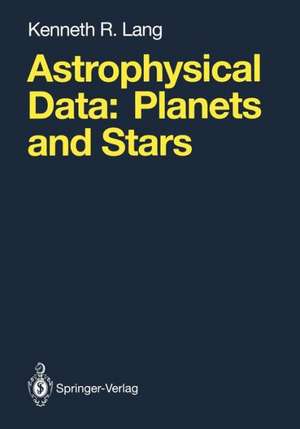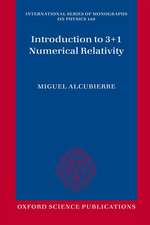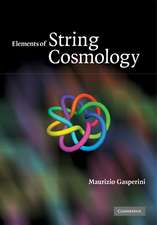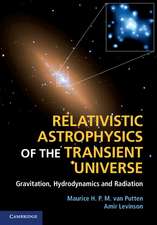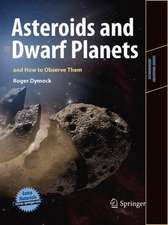Astrophysical Data: Planets and Stars
Autor Kenneth R. Langen Limba Engleză Paperback – 29 mar 2012
Preț: 439.51 lei
Nou
Puncte Express: 659
Preț estimativ în valută:
84.13€ • 91.41$ • 70.71£
84.13€ • 91.41$ • 70.71£
Carte tipărită la comandă
Livrare economică 21 aprilie-05 mai
Preluare comenzi: 021 569.72.76
Specificații
ISBN-13: 9781468406429
ISBN-10: 1468406426
Pagini: 960
Ilustrații: X, 937 p.
Dimensiuni: 178 x 254 x 55 mm
Greutate: 1.63 kg
Ediția:Softcover reprint of the original 1st ed. 1992
Editura: Springer
Colecția Springer
Locul publicării:New York, NY, United States
ISBN-10: 1468406426
Pagini: 960
Ilustrații: X, 937 p.
Dimensiuni: 178 x 254 x 55 mm
Greutate: 1.63 kg
Ediția:Softcover reprint of the original 1st ed. 1992
Editura: Springer
Colecția Springer
Locul publicării:New York, NY, United States
Public țintă
ResearchDescriere
This volume of Astrophysical Data deals with Planets and Stars; a second volume, Part II, will give data for Galaxies and the Universe. They both pro vide basic data for use by all scientists, from the amateur astronomer to the professional astrophysicist. In this first volume, we not only provide physical parameters of planets, stars and their environment, but we also provide the celestial coordinates required to observe them. Here we use c.g.s. units, for they are the most commonly used in astron omy and astrophysics; but our volume begins with astronomical and physical constants and the conversion factors needed for other units. The next section concerns the planets and their satellites; it singles out the Earth and Moon for special treatment. Spacecraft rendezvous with the planets and satellites have led to improved values for their atmospheric compositions, orbital parameters, magnetic fields, masses, radii, rotation periods, and surface pressures and temperatures. This section also contains data for the asteroids, comets and their debris. We then discuss everyday stars, beginning with the Sun, and continuing with basic stellar data, the brightest stars and nearby stars. Special categories of stars, such as the Wolf-Rayet stars, magnetic stars, flare stars, and RS CVn binary stars, are included.
Cuprins
I. Constants and Conversion Factors.- 1. Constants and Units.- 1.1 Physical Constants.- 1.2 Astronomical Constants.- 1.3 Conversion Factors.- II. Planets and their Satellites.- 2. Planet Earth.- 2.1 Physical Parameters and Motions of the Earth.- 2.2 Timescales on Earth.- 2.3 Terrestrial Atmosphere.- 2.4 Terrestrial Impact Craters.- 3. The Planets.- 3.1 The Planetary System.- 3.2 Physical Parameters of the Planets.- 3.3 Planetary Atmospheres.- 3.4 Planetary Rings.- 4. The Moon.- 4.1 Physical Parameters and Motions of the Moon.- 4.2 Lunar Maria and Craters.- 5. Satellites of the Planets.- 5.1 General Properties of the Satellites.- 5.2 Physical Elements for the Principal Satellites.- 5.3 Physical Elements for the Small Satellites.- 6. Asteroids and their Debris.- 6.1 General Properties of the Asteroids.- 6.2 Selected Asteroids: Physical and Orbital Elements.- 6.3 Concentrations of Asteroids.- 6.4 Asteroid Debris.- 6.5 Solar System Abundances of the Elements.- 7. Comets and their Debris.- 7.1 Structural Properties of Comets.- 7.2 Origin and Statistics of Comets.- 7.3 Comets of Special Interest.- 7.4 Long Period and Short Period Comets.- 7.5 Cometary Debris.- III. The Stars.- 8. The Sun.- 8.1 Basic Solar Data.- 8.2 Standard Solar Model.- 8.3 Solar Neutrinos.- 8.4 The Outer Solar Atmosphere.- 9. Basic Stellar Data.- 9.1 Physical Parameters of the Stars.- 9.2 Numerical Relations and Laws.- 9.3 Observed Angular Diameters of Stars.- 9.4 Stellar Masses.- 9.5 Spectral Classification of the Stars.- 9.6 Stellar Mass, Radius, Density and Rotation.- 9.7 Stellar Temperature and Luminosity.- 9.8 Absolute Visual Magnitudes of the Stars.- 9.9 Colors of the Stars.- 10. Bright and Nearby Stars.- 10.1 Named Stars and Constellations.- 10.2 The Nearest and Brightest Stars.- 10.3 Catalogue of 446 Stars Brighter than Apparent Visual Magnitude 4.00.- 11. Wolf-Rayet Stars.- 11.1 Basic Data for Wolf-Rayet Stars.- 11.2 Catalogue of Wolf-Rayet Stars.- 12. Magnetic Stars.- 12.1 Basic Data for Magnetic Stars.- 12.2 Catalogue of Nondegenerate Magnetic Stars.- 13. Stellar Activity.- 13.1 General Properties of Flare Stars.- 13.2 Catalogue of Nearby Flare Stars.- 13.3 Catalogue of RS CVn and BY Dra Binaries — Part I.- 13.4 Catalogue of RS CVn and BY Dra Binaries — Part II.- IV. Star Clusters and Associations.- 14. Globular Clusters.- 14.1 Basic Data for Globular Clusters.- 14.2 Catalogue of Globular Clusters — Part I.- 14.3 Catalogue of Globular Clusters — Part II.- 15. Open Clusters.- 15.1 Basic Data for Open Clusters.- 15.2 Catalogue of Open Clusters.- 16. OB Associations.- 16.1 Basic Data for OB Associations.- 16.2 Catalogue of OB Associations.- V. The Stellar Environment.- 17. Regions of Star Formation.- 17.1 Molecular Clouds and Dust Clouds.- 17.2 T Tauri Stars and Related Objects.- 17.3 Herbig-Haro Objects.- 18. Diffuse Emission Nebulae or H II Regions.- 18.1 Basic Data for Emission Nebulae.- 18.2 Emission Nebulae at Optical Wavelengths.- 18.3 Emission Nebulae at Radio Wavelengths.- 19. Reflection Nebulae.- 19.1 Basic Data for Reflection Nebulae.- 19.2 Catalogue of Reflection Nebulae.- 20. Planetary Nebulae.- 20.1 Basic Data for Planetary Nebulae.- 20.2 Catalogue of Planetary Nebulae — Part I.- 20.3 Catalogue of Planetary Nebulae — Part II.- VI. Dying Stars.- 21. White Dwarf Stars.- 21.1 Basic Data for White Dwarf Stars.- 21.2 Catalogue of White Dwarf Stars.- 21.3 Cross-Reference Name Index for White Dwarf Stars.- 22. Pulsars.- 22.1 Basic Data for Pulsars.- 22.2 Catalogue of Pulsars — Part I.- 22.3 Catalogue of Pulsars — Part II.- 23. Candidate Black Holes.- 23.1 Catalogue of Candidate Black Holes.- VII. Interacting Binary Systems.- 24. Cataclysmic Binary Systems.- 24.1 Basic Data for Cataclysmic Binary Systems.- 24.2 Cataclysmic Binaries with Known Periods.- 24.3 Catalogue of Classical Novae.- 24.4 Catalogue of Dwarf Novae.- 25. Symbiotic Stars.- 25.1 Basic Data for Symbiotic Stars.- 25.2 Catalogue of Symbiotic Stars.- VIII. Supernovae Explosions and their Remnants.- 26. Supernovae.- 26.1 Basic Data for Supernovae.- 27. Supernova Remnants.- 27.1 Basic Data for Supernova Remnants.- 27.2 X-Ray Radiation from Supernova Remnants.- 27.3 Catalogue of Galactic Supernova Remnants.- 27.4 Cross-Reference Name Index for Supernova Remnants.- IX. High Energy Radiation From Stars.- 28. X-Ray and Gamma Ray Sources.- 28.1 Compact X-Ray Sources.- 28.2 Low-Mass X-Ray Binaries.- 28.3 Gamma Ray Sources.- 29. Appendix.- 29.1 Catalogue of Nearby Stars.- References.
